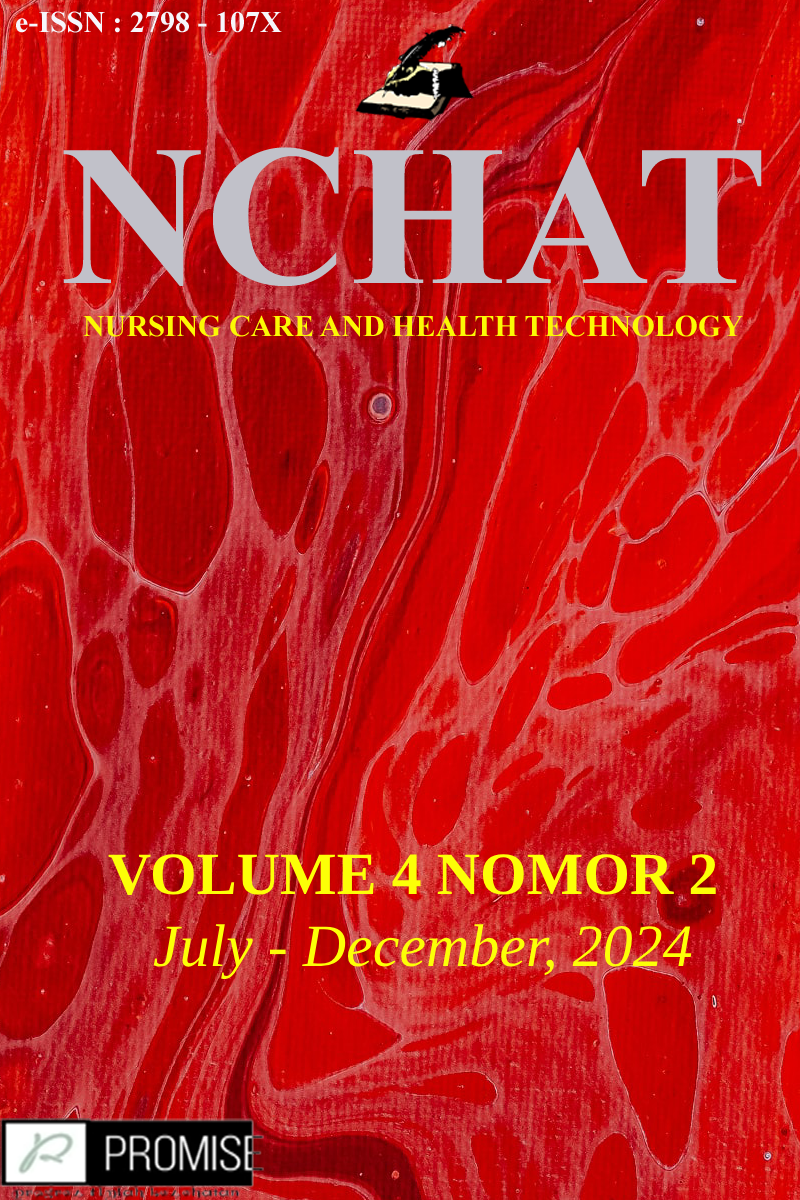Hubungan IMT dengan Dislipidemia pada Pasien PJK yang Menjalani Tindakan Percutaneus Coronary Intervention
DOI:
https://doi.org/10.56742/nchat.v4i2.86Abstract
Penyakit Jantung Koroner (PJK) penyebab kematian nomor satu di dunia. Dislipidemia ditetapkan sebagai faktor resiko mayor terjadinya PJK menurut WHO-community study of elderly yang dapat menyebabkan aterosklerosis. Obesitas menjadi masalah kesehatan di negara-negara berkembang, data Survei Kesehatan Indonesia 2023 menunjukkan peningkatan prevalensi obesitas sejak periode tahun 10.5% (2007) sampai 23.4% (2023). Semakin tinggi Indeks Massa Tubuh (IMT), semakin besar juga risiko akumulasi lemak yang mempengaruhi profil lipid. Penelitian ini bertujuan menganalisis hubungan IMT dengan dislipidemia pada pasien PJK yang menjalani tindakan Percutaneus Coronary Intervention (PCI). Desain penelitian korelasional dengan pendekatan potong lintang dilaksanakan di RS tipe B dengan sampel sebanyak 105 pasien PJK yang dilakukan PCI periode tahun 2020 yang ditentukan secara total sampling. Instrumen penelitian menggunakan penelusuran data rekam medik terkait nilai IMT dan hasil pemeriksaan lemak darah. Uji koefisien kontingensi digunakan untuk menentukan hubungan antara kedua variabel. Hasil menunjukkan 72 (68.6%) responden berjenis kelamin laki-laki. usia rata-rata 55 tahun dengan kelompok usia berisiko > 45 tahun sebanyak 87 orang (82.9%), responden dengan IMT kategori lebih, sebanyak 46 orang (43.8%), responden dengan dislipidemia sebanyak 41 orang (39.0%). Hasil analisis bivariat didapatkan nilai p = 0.042 artinya terdapat hubungan antara IMT dengan dislipidemia pada pasien PJK dengan tindakan PCI. Nilai korelasi sebesar 0.194 menunjukkan korelasi positif dengan kekuatan korelasi yang lemah. Kesimpulan penelitian bahwa IMT yang berlebih memiliki hubungan yang signifikan dengan dislipidemia pada pasien PJK yang menjalani tindakan PCI.
References
World Health O. Cardiovascular Diseases (CVDs) 2020 [Available from: https://www.who.int/news-room/fact-sheets/detail/cardiovascular-diseases-(cvds).
Kementerian Kesehatan Republik Indonesia. Riset Kesehatan Dasar 2018 (Riskesdas 2018). Jakarta: Kemenkes RI; 2018.
Santos IS, Machado JA, Cardoso SS. Relationship Between Obesity, Dyslipidemia, and Cardiovascular Risk. Journal of Clinical Lipidology. 2021;15(2):157-68.
Zhao Z, Zhang H, Liu Y. Impact of Percutaneous Coronary Intervention on Clinical Outcomes in Patients With Coronary Artery Disease. Heart Disease & Stroke Journal. 2019;27(3):208-15.
Gencer B, Pizzi C, Lüscher TF. Risk Factors for Adverse Outcomes After PCI The Importance Of Lipid Control. European Heart Journal. 2020;41(8):903-10.
Wang Y, Liu Y, Zhang W. Obesity and Dyslipidemia: Role in Coronary Artery Disease and Implications For PCI Outcomes. Journal of Cardiovascular Disease Research. 2020;11(3):181-9.
Liu Z, Yu L, Zhang Q. Obesity and Dyslipidemia as Predictors Of Adverse Outcomes In Coronary Artery Disease: Impact On Pci Results. International Journal of Cardiovascular Sciences. 2021;34(5):332-8.
Huang H, Li X, Zhou Y. The Impact of Obesity on Coronary Artery Disease And Percutaneous Coronary Intervention Outcomes. Cardiology Journal. 2022;29(1):45-53.
Fisher CE, Kent JC. Research Methods in Health: Investigating Health and Health Services. London: SAGE Publications; 2018.
Campbell MJ, Machin D, Walters SJ. Medical Statistics: A Textbook for the Health Sciences. Chichester: Wiley; 2019.
Micha R, et al. Effect of Dietary Factors On Cardiovascular Disease Outcomes. The Lancet. 2018;391(10128):1811-22.
Paquette M, et al. Gender and Age Differences In Lipid Management In Cardiovascular Disease Patients. Journal of Clinical Lipidology. 2021;15(2):135-42.
Bertolotto A, et al. Gender Differences in The Effects of Obesity on Lipid Metabolism: Implications for Cardiovascular Risk. Journal of Clinical Endocrinology & Metabolism. 2019;104(4):991-1001.
Buchfuhrer AH, et al. Impact of Obesity on Lipid Profiles and Cardiovascular Outcomes in Older Adults. Journal of Clinical Cardiovascular Medicine. 2020;33(1):45-53.
Khera A, et al. Association Between Age and Cardiovascular Disease Risk In Adults With Dyslipidemia. American Journal of Cardiology. 2019;123(3):438-45.
Snyder PJ, et al. Age-Related Changes in Lipid Metabolism and Their Implications For Cardiovascular Disease. American Journal of Medicine. 2019;132(3):355-65.
Allahyari A, Jernberg T, Hagström E, Leosdottir M, Lundman P, Ueda P. Application of The 2019 ESC/EAS Dyslipidaemia Guidelines to Nationwide Data of Patients With A Recent Myocardial Infarction: A Simulation Study. European Heart Journal. 2020;41(40):3900-9.
Reusch JEB, Regensteiner JG, Stewart KJ, Veves A. Diabetes and Exercise: From Pathophysiology to Clinical Implementation. Berlin: Springer; 2018.
Bavishi C, et al. Lipid Management in Patients with Coronary Artery Disease: Current Evidence and Future Directions. American Heart Journal. 2020;224:67-76.
Zhang M, et al. Association of Body Mass Index With Dyslipidemia and Cardiovascular Events in A Large Cohort Of Patients With Coronary Artery Disease. Journal of Clinical Lipidology. 2021;15(3):400-8.
Smith JW, et al. Impact of Obesity On Lipid Profile And Cardiovascular Risk In Patients With Coronary Artery Disease Undergoing PCI. European Journal of Preventive Cardiology. 2019;26(6):595-603.
Nguyen T, et al. Obesity and Lipid Metabolism Dysfunction In Patients With Coronary Artery Disease: Implications For Percutaneous Coronary Intervention. Journal of the American College of Cardiology. 2020;79(5):520-8.
Smith ML, et al. Lifestyle Modification to Improve Lipid Profiles and Cardiovascular Health. Journal of the American Heart Association. 2019;8(2):e011853.
Sacks FM, et al. Diet and Cardiovascular Risk Factors: Current Evidence And Recommendations. New England Journal of Medicine. 2018;379:1970-82.
Buchfuhrer AH, et al. Effects of Aerobic and Resistance Exercise on Lipids in Patients with Cardiovascular Disease. The Journal of Cardiovascular Nursing. 2021;36(4):367-75.
Jacob L, et al. The Effects of Physical Activity on Lipid Metabolism and Cardiovascular Health. European Journal of Preventive Cardiology. 2019;26(6):595-603.
Downloads
Published
How to Cite
Issue
Section
License
Copyright (c) 2024 Arfiyan Sukmadi, Haryati

This work is licensed under a Creative Commons Attribution 4.0 International License.





